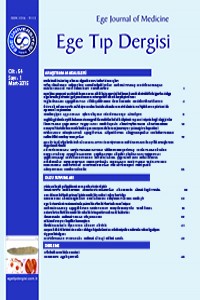Abstract
Aim: Extracorporeal shock wave lithotripsy (ESWL) is a favourable and succesful treatment method for ureter stones. It is highlighted that ESWL can be the first treatment choice for ureter stones. In this study, the results of patients who had ESWL treatment for proximal ureter stones were examined in the light of pertinent literature. Materials and Methods: Between January 2013-January 2014, ESWL is proposed to 114 patients who had proximal ureter stone and who didn't benefit from medical treatment. Since eighteen patients could not be followed, 96 patients were included in the study. All patients evaluated with non-contrast computed tomography (NCCT). Average stone size was 9.42 mm (5-16 mm) and all them were opaque. All patients had ESWL treatment for 3 session with 60 frequency per minute, with a 17-20 kV power and 2500 beats per session. After 3 sessions of ESWL, the patients who finished whole treatment were evaluated with NCCT to assess the success of treatment after a waiting period of one month. Results: ESWL was successful in 69 (69.79%) patients. In 29 (30.21%) patients there was no change in stone size, so ureterorenoscopy was suggested. Success status was evaluated regarding stone size. Stones were completely fragmanted in 42 (79.2%) of 53 patients who had stones with a dimension of 1 cm or less, and in 25 (%58.1) of 43 patients who had stones with a dimension greater than 1 cm. Conclusion: ESWL can be considered as a relatively low-cost, non-invasive, reliable and succesful method of treatment for ureter stones.
Keywords
Abstract
Amaç: Üreter taşları için uygun ve başarılı bir tedavi yöntemi olan ekstrakorporal şok dalga litotripsi (extracorporeal shock wave lithotripsy, ESWL) üreter taşlarının tedavisinde ilk seçenek olarak öngörülebilir. Bu çalışmada proksimal üreter taşı olup ESWL tedavisi uygulanan hastalardaki sonuçlar incelenmiş ve literatür eşliğinde tartışılmıştır. Gereç ve Yöntem: Ocak 2013-Ocak 2014 tarihleri arasında proksimal üreter taşı olup tıbbi tedavi ile sonuç alınamayan 114 hastaya ESWL tedavisi önerildi. 18 hasta takip dışı kaldığından 96 hasta çalışmaya dahil edildi. Tüm hastalara kontrastsız bilgisayarlı tüm batın tomografisi çekildi. Taş boyutu ortalama 9.42 mm (5-16 mm) olup tümü opaktı. Dakikada frekans 60, 17-20 kV güçte ve seans başına 2500 vuruş ile her bir hastaya toplam 3 seans ESWL uygulandı. Üç seans tamamlayan hastalarda bir ay bekleme süresinden sonra kontrastsız bilgisayarlı batın tomografisi çekilerek başarı durumu değerlendirildi. Bulgular: Altmış yedi hastada (%69.79) ESWL tedavisi başarılı oldu. 29 hastada (%30.21) taşta herhangi bir değişiklik olmadı ve hastalara üreterorenoskopi planlandı. Taş boyutuna göre başarı dururumu değerlendirildi. Taş boyutu 1 cm ve altında olan 53 hastanın 42'sinde (%79.2), taş boyutu 1 cm'nin üzerinde olan 43 hastanın ise 25'inde (%58.1) taşlar tamamen kırıldı. Sonuç: ESWL üreter taşlarının tedavisinde nispeten düşük maliyetli, invaziv olmayan, güvenilir ve başarılı bir tedavi yöntemi olarak öngörülebilir.
Keywords
Details
| Other ID | JA87ZJ43GH |
|---|---|
| Authors | |
| Publication Date | March 1, 2015 |
| Submission Date | March 1, 2015 |
| Published in Issue | Year 2015 Volume: 54 Issue: 1 |
Ege Journal of Medicine enables the sharing of articles according to the Attribution-Non-Commercial-Share Alike 4.0 International (CC BY-NC-SA 4.0) license.

